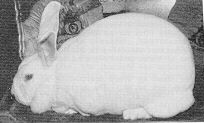

Profile of proper spine curvature
According to the ARBA Standard of Perfection, the Rex rabbit is considered a Commercial Type Group "D". Under General Type- Body, it states that the ideal Rex should exemplify meat producing qualities with well rounded hips, well filled loins, ribs and shoulders and to have enough depth to balance other portions.
I feel one thing is missing from the Rex standard concerning General Type. The standard should include in a revised version the wording under Body Type of the New Zealand standard which states "the top body line should rise in a gradual curve from the base of the ears to the center of the hips and then fall in a smooth curve downward to the base of the tail."
The reason I would like to have the "Top Line" wording added to the Rex standard is for breeder's benefit to aid in their breeding, culling and selection of breeding pieces.
The "top line" or curvature of the spine is what lends itself to all commercial breeds of rabbits. It is the high point of the "Top Line or profile at the center of the hips that defines depth and allows for fullness at the back of the hips and sides.
It is with a proper "Top Line" rising as high as the rabbit is wide at the center of the hips that allows Rex Rabbits to attain prescribed weights while increasing production capabilities due to an enlarged body cavity. Because Rex rabbits are generally short in body (15 to 17 inches) and have medium to fine bone, it is rather obvious that the more depth we have on our Rex, the greater the possibility of achieving body weights set by the standard and all the while creating a more pleasant to look at animal.
I am convinced that if you are to be a consistent winner on the show table, you must employ the "Top Line" theory to your breeding program.
The breeder who utilizes the "Top Line" theory in his herd will be rewarded with 35 points allotted to body in the Rex standard. The 10 points for head, ears, eyes, feet, legs and tail are then more naturally accomplished. The 5 points for condition are easily accounted for in the management practices of the Showman. All showmen are experienced conditioners of the animal they exhibit.
Coupled with the "Top Line" theory is another theory I have learned, i.e., that body type or spine curvature does not alter itself from the age of six weeks through adulthood. It becomes rather obvious that the small rabbit is a miniature version of his adult development.
Knowledge is the key to success in any area, and the same applies to the "Top Line" theory. The breeder's success will be directly proportional to his ability to detect proper spine curvature within his animals or from purchased stock and to breed his best "Top Line" animals together to lock in genetically the highly desired characteristic. The breeder should select the best "Top Line" animals from his mating and inbreed them to strengthen his gene pool for out-crossing to another strain that "nicks" well when mated to the superior type animals. Hopeful, the outcross strain has had the "Top Line" theory applied to it as well. Of course, I am speaking to one area of the overall gene pool when relating to this article and that being - "Spine Curvature."
The "Top Line" theory really works, ask the consistent show winners.
Ron & Wava Roye İTexas Pride Rabbitry Used by permission 2/97